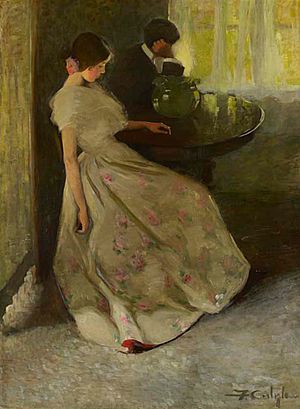Florence Carlyle facts for kids
Quick facts for kids
Florence Carlyle
|
|
|---|---|

Florence Carlyle, c. 1890.
|
|
| Born | 1864 Galt, Ontario, Canada
|
| Died | May 2, 1923 (aged 58–59) Crowborough, England
|
| Known for | Painter |
| Partner(s) | Juliet Hastings |
Florence Emily Carlyle (born September 24, 1864, died May 2, 1923) was a talented Canadian artist. She was famous for painting people and portraits, especially how she used light and different fabrics in her art. You can find her paintings in the National Gallery of Canada.
Contents
Florence Carlyle's Early Life
Florence Carlyle was born on September 24, 1864, in Galt, Ontario. Her parents were Emily Youmans Carlyle and William Carlyle. She was the second oldest of seven children. Her family and friends often called her "Bird."
In 1871, Florence's family moved to Woodstock, Ontario. Her father, William Carlyle, worked there as a school inspector. Florence's mother, Emily, created an art studio at their home. She hired artists to teach local children who wanted to learn about art.
Emily noticed Florence's artistic talent. She arranged for Florence to have private drawing and painting lessons. Her teacher was William Lees Judson.
Early Recognition for Her Art
In 1883, Florence and her younger sister, Lilian, showed some of their artwork. This was at the Ladies' Department of the Toronto Industrial Exhibition. This event helped Florence become widely known.
Princess Louise and her husband, the Marquis of Lorne, bought one of Florence's paintings. It was a picture of white lilies painted on china. Important newspapers like The Globe and Daily Mail wrote about this exciting event.
Studying Art in Paris

Florence knew she needed to study more to improve her art skills. So, when she was 26, she moved to Paris, France. She arrived there on November 3, 1890.
Florence traveled to Paris with her art teacher, Paul Peel, his sister Margaret, and their father. But once in Paris, Florence rented her own apartment.
At first, it was hard for Florence to find an art school that accepted women. Many schools also separated men and women in classes. Florence first went to the Académie Julian. After a disagreement with Adolphe-William Bouguereau, she moved to a different school, the Académie Delécluse. By 1892, she returned to Académie Julian to finish her studies.
In 1893, Florence showed her painting Une Dame Hollandaise at a famous art show. This was the Salon of the Société des Artistes Français. Her painting received good attention. Florence returned to Woodstock, where her family lived, in 1896.
Later Years and Achievements
Florence Carlyle had art studios in London and Woodstock. In 1897, she made history. She became the first woman to be chosen as an Associate of the Royal Canadian Academy. This was a very important achievement for a female artist at that time.
In 1899, she opened another studio in New York City. In 1904, her oil painting The Tiff was chosen for a special art show. This was the Canadian exhibition at the Louisiana Purchase Exposition. Her painting won a silver medal there.
The Montreal Gazette newspaper described The Tiff as a "strong piece of work." It said the painting showed "a lover's quarrel" and praised how clearly and precisely it was painted. Today, this painting is part of the Art Gallery of Ontario's collection.
Florence spent the last twenty years of her life in Crowborough, Sussex, England. She and her friend, Juliet Hastings, bought a charming English cottage there. They named their home "Sweet Haws."
Florence Carlyle passed away in Crowborough in the spring of 1923. Most of her artwork, about 55 pieces, is now in the collection of the Woodstock Art Gallery in Woodstock, Ontario.

